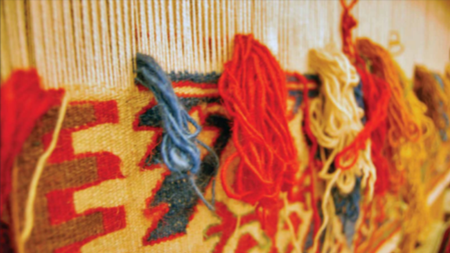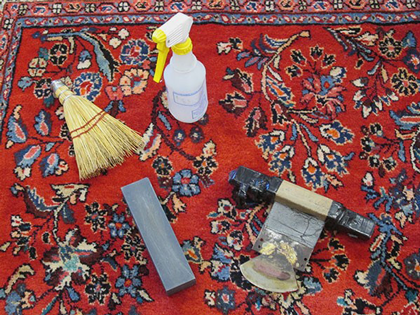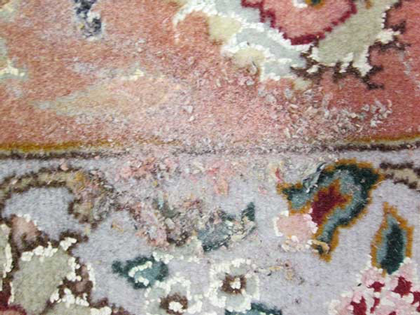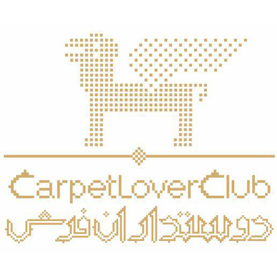shearing of handmade carpet and picturial rug for leveling of carpet surface
pictorial handmade rugs : usage of landscapes, flower and face pattern for rug weaving
August 6, 2018kurdish handmade carpet: kurdistan carpet weaving process inspired by nature
August 7, 2018
The shearing of the rug is an often overlooked art form. Shearing is mostly done by hand because machine shearing tends to leave lines and divots across the pile. A master shearer will roll the rug backward, using a steadied hand and trained eye to trim the rug using a simple yet large pair of shears. If the pile is trimmed too long, the pattern will appear “fuzzy” or almost out of focus. If the pile is trimmed too short, you will be able to see the gaps and warps between the rows of knots. This not only ruins the pattern, but also decreases the life of the rug.
The Process of fabricating carpets

Carpet weaving technique is not just a mechanical process, the weaver rather weaves within its threads the history of his cultural tradition. Every single weaved design speaks of a culture that has been transferred from one generation to the other. The beauty of carpet weaving thus lies in displaying this story of culture being weaved through the threads by the weaver to finally produce a design with a meaning, structure, and an identity of its own that appears organic in nature. It would not be wrong to say that weaving carpet is like weaving culture through threads to produce tangible specimens of one’s intangible cultural heritage and care your carpet for a long life. From the traditional rugs made by tribal shepherds to the rugs made by power looms of carpet factories, rugs have travelled a long journey. Over the centuries, there have been new techniques to weave beautiful rugs. Rug making is time consuming and involves a number of stages. Let’s take on this fascinating journey of how carpets are produced to become such exquisite samples of dexterity, luxury and adornment.
yarn processing
- From wool to yarn – Before the actual carpet weaving process takes place, there is lot that goes in making the yarn. Raw wool has to be converted to yarn through HAND OR machines where the wool is converted into individual strands which are further spun into yarn. Yarn further undergoes a spinning process through various other machines that make it strong enough. This follows by cleaning the yarn with detergent and later rinsing many times with clean water and finally the yarn is sun dried for a couple of days. After drying the yarn is rolled into balls that facilitate weaving and knotting. This is how raw wool is turned into refined yarn that can be used in weaving carpets.
- Dyeing of the yarn – Giving appropriate color to the yarn is one of the most important and visually appealing property of the carpets. Dyes are produced with great caution to derive exact shades as required for the carpet design. Yarns are dipped in dyes which are heated to the boiling temperatures for certain definite amount of time. After the dyeing takes place, the dyed yarns are placed under mild sun for drying.
weaving stage
A detailed illustration of the carpet design, most commonly called a cartoon, guides the weavers throughout the entire rug-making process. The design is rendered on graph paper to scale. Through the ages, looms have remained relatively unchanged. While the most primitive is the nomadic or horizontal loom, the type most generally used today consists of two vertical beams of either wood or metal and two similarly made horizontal beams. The distance between the vertical beams determines the rug’s width. Warp threads, usually cotton, are strung between the horizontal beams at a consistent tension. The thickness of the warp threads and the closeness at which they are strung are two of the elements that will determine the fineness of the weave (i.e., knot density) of the carpet that is ultimately woven.

Turkish/ Symmetrical Knot ، Persian/Asymmetrical Knot
There are two types of knots used in rug-weaving: the Turkish knot (also called Ghiordes or symmetrical knot) and the Persian knot (also known as Senneh or asymmetrical knot). With the average weaver able to tie 10,000 to 14,000 Turkish or Persian knots a day, several weavers working together can only complete one or two inches of the carpet a day. Before the actual knotting of the pile begins, the rug is secured at the bottom of the loom by a short kilim, a flat pileless fabric, which is woven by passing several rows of horizontal cotton threads, or wefts, through alternate warp threads. After rolling the different-colored yarns to be used into balls, the weaver, reading the design from the cartoon begins weaving the rug. With the appropriate color yarn, the weaver ties a knot around two adjacent warps, slides the knot down to the base of the weft, and then cuts the yarn with a knife, thereby producing the pile. After each row of knots is completed, one or more weft threads are inserted to secure the knots and are beaten down tightly with a comb. At this stage, the pile ends are often cut level with a pair of shears. The alternation of wefts with rows of tied knots is repeated until the carpet is finished. Before removing the rug from the loom, another kilim is woven at the top. The fringe is formed by the cutting of the warps at both ends of the rug.
The Finishing Process
Once the yarn is woven into a rug, there are few steps in the final processing of the rugs.
- Trimming, washing and drying of the rug – soon after the weaving, the rug is taken off from the loom for its trimming. The surface of the rug is smoothen out by removing extra hanging fibers. Pointed sharp scissors are used for this levelling. This trimming brings out the clarity in the design of the rug. After trimming, the rug is washed with detergent and later with only with clean water to get rid of all the dirt and left over detergent. A wood plank with a sharp edge is used to force water through rug for better cleansing. Later the rug is left under sunlight for drying for about four-five days.
- Rug shaving, and levelling is again done after rug has completely dried. This enhances the design, colors and levels the rug along its length and breath. This happens o be the most delicate part of the carpet finishing process.
antique carpets shearing and trimming
Handmade rugs last a long time. However, the wear and tear of everyday life, year after year, combined with neglect, can make them look grimly. But underneath that surface layer of worn out wool fiber, there still may be a gem. Shearing gives an older, worn-out Oriental rug or Persian carpet a new finish. It removes uneven pile heights and tuffs, fuzzing, peeling, uneven seams, matting, or discoloration. It makes any rug look newer by enhancing color, finish, clarity, pattern and definition.
- If the color is sun faded, by lightly shaving we can get to the tip of the color to bring back the original, bright, vibrant color.
- Over time, wearing of the rug causes the design to appear dull, by light shaving, we can bring back the original bright design.
- Shearing is also used to thin out rugs which a number of customers prefer.
- New rugs are shaved to give it an older look.
- Some people like to shave their rugs unevenly to have a certain area appear more worn.
- Once a rug is weaved, shearing is performed to make the pile even.
- A part of the rug may have a high traffic area and may appear to be more worn then the rest of the rug.
- Shearing helps remove fuzz from the rug. PROFESSIONALS shave the top of the rug fiber, which makes the rug design clearer and eliminates the fuzz. This process also leaves the rug with a glossy finish.
shearing stages of faded and dameged carpets
After a rug has faded from exposure to strong sunlight, you can push down between the fibers to see the original color hiding under the faded area. This lets you know that only the top layer of wool is faded, and the original color is waiting to be revealed. In the photo below, you can see how the top layer of this red rug has turned almost white from sun bleaching.

A standard set of tools is used by the rug restoration specialist to remove just the top layer of wool, revealing the brighter wool underneath. In the photo, you see the spray bottle of water that wets the wool as it is sheared, the shearing blade that glides across the surface of the rug to remove the faded wool, the whetstone that sharpens the blade as we go, and the whisk broom that sweeps away the wool “dust” created by shearing.

As shearing is completed section by section, the wool that is removed appears as a fine dust that is just swept away and discarded. The thickness of the rug is only minimally impacted by shearing, as just the finest layer necessary is removed across the surface of the whole rug. In the photo below, little specks of pink wool have collected next to the area being sheared.

A little section of the rug below has been sheared to reveal the warm rose color previously obscured by the pale pink wool that laid over it. Originally, before the sun did its worst, all of the washed out, pale pink areas in the photo were this stronger shade of rose.

The image below is a single photo. The black line has been added to make very clear the division between the sheared and unsheared areas of the rug. This rug went from almost powder pink back to the vibrant lipstick red of the original.

And let’s close this one out by showing how the rug pictured above looks after being freshly sheared. The former ruby glory of this handmade Persian Sarouk( has been fully restored!

